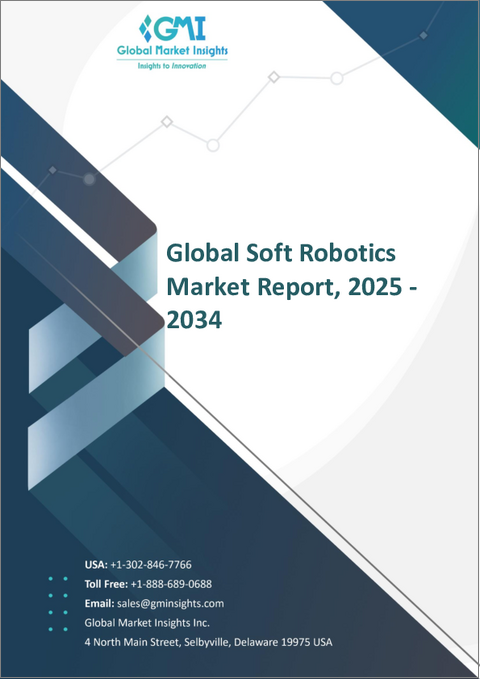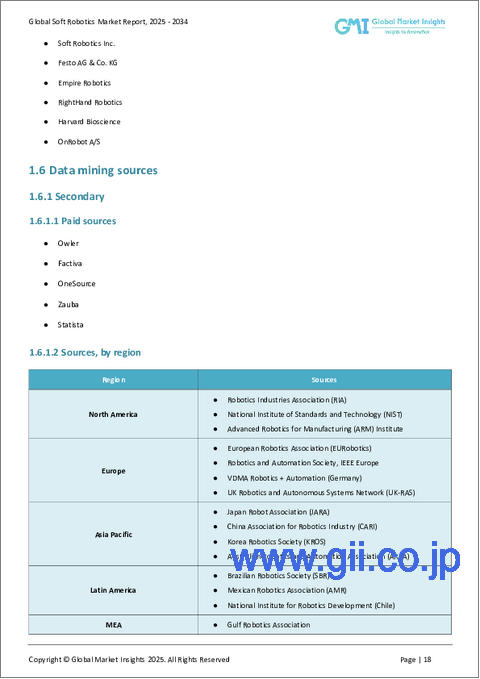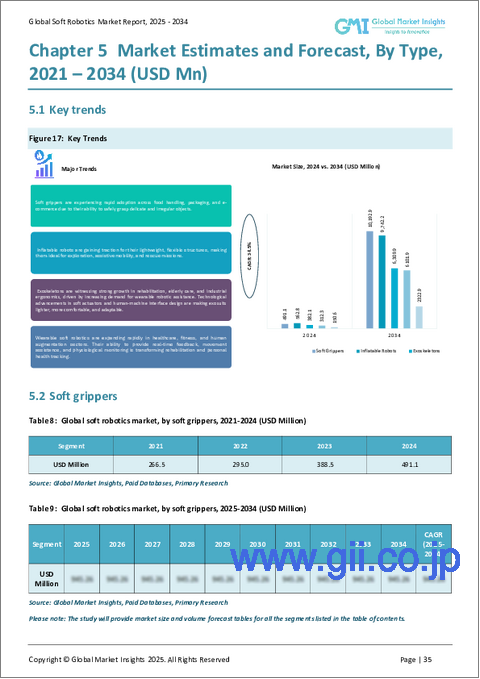|
|
市場調査レポート
商品コード
1698544
ソフトロボット市場の機会、成長促進要因、産業動向分析、2025年~2034年の予測Soft Robotics Market Opportunity, Growth Drivers, Industry Trend Analysis, and Forecast 2025-2034 |
||||||
カスタマイズ可能
|
|||||||
| ソフトロボット市場の機会、成長促進要因、産業動向分析、2025年~2034年の予測 |
|
出版日: 2025年02月06日
発行: Global Market Insights Inc.
ページ情報: 英文 190 Pages
納期: 2~3営業日
|
全表示
- 概要
- 目次
ソフトロボットの世界市場は2024年に18億9,000万米ドルとなり、2034年までに353億3,000万米ドルに達し、2025年から2034年にかけてCAGR 34.8%で成長すると予測されています。
自動化需要の高まりとヘルスケアおよびホスピタリティ産業の拡大が、この成長に拍車をかけています。産業界は自動化を強化するためにソフトロボットを統合しており、ロボットがさまざまな分野で複雑な作業をこなせるようにしています。ヘルスケア、ロジスティクス、製造業でソフトロボットの採用が増加しており、デリケートな対象物を正確かつ効率的に処理できることが市場拡大に寄与しています。

ヘルスケア分野では、高齢化の進展と労働力不足がロボットによる自動化の需要を加速させています。この業界では、業務の合理化、反復作業の自動化、患者ケアの向上を目的に、ソフト・ロボットに注目が集まっています。これらのロボットはリハビリを支援し、繊細な外科手術を行い、業務効率を高めることで医療従事者をサポートすることができます。同様に、ホスピタリティ業界では、サービス提供の自動化を統合し、効率を向上させながら運営コストを削減しています。ロジスティクス分野でも、サプライチェーン管理の最適化、在庫処理の自動化、全体的な生産性向上のためにソフトロボットの導入が進んでいます。
| 市場範囲 | |
|---|---|
| 開始年 | 2024 |
| 予測年 | 2025-2034 |
| 開始金額 | 18億9,000万米ドル |
| 予測金額 | 353億3,000万米ドル |
| CAGR | 34.8% |
ソフトロボットは、タイプ別にソフトグリッパー、インフレータブルロボット、外骨格、ウェアラブルに区分されます。産業オートメーション、農業、ヘルスケアで広く使われているソフトグリッパーは、デリケートなアイテムを扱うための柔軟なソリューションを提供します。ソフトグリッパー市場は、倉庫や製造施設での採用増加により、2024年には6億6,990万米ドルと評価されます。高度な感覚フィードバック、ビジョンシステム、強化されたデザインの開発により、効率性と汎用性がさらに向上しています。膨張式ロボットは、2034年までに74億1,000万米ドル以上と評価され、その軽量で適応性の高い構造により、医療用途、災害対応、宇宙探査に理想的なロボットとして人気を集めています。
コンポーネント別では、ソフトアクチュエータ、センサー、制御システム、電源が市場に含まれます。ソフトアクチュエータ分野は、ヘルスケア、物流、農業における自動化の必要性により、2034年までに138億8,000万米ドルを超えると見られています。ソフトセンサーは2024年に市場の25.7%を占め、AIベースのオートメーションや触覚センシング技術で重要な役割を果たしています。制御システムは、2034年までに57億米ドル以上と評価され、ロボット操作の自律性を強化するためにAIと機械学習を統合しています。2024年に25.7%の市場シェアを占める電源も、コンパクトで効率的なエネルギー・ソリューションの革新によって進化しています。
市場はさらに、エラストマー、ゲル、ファブリックなど素材別に区分されます。2024年の市場シェアはエラストマーが10.3%を占め、ロボット用途に高い柔軟性と弾力性を提供しています。熱や電気などの刺激に適応するゲルベースのロボットは、生物医学や製薬用途で人気を集めています。布地一体型のソフトロボットはウェアラブル技術を進歩させ、補助医療機器や補助衣料に最適です。
アプリケーションはヘルスケア、食品・物流、自動車、農業など多岐にわたる。2025年から2034年にかけてCAGR 35.2%で成長すると予測されるヘルスケア分野では、義肢装具、移動支援、外科手術にソフトロボットが活用されています。飲食品分野は2034年までに117億8,000万米ドル以上に達する見込みで、加工、包装、品質管理のための自動化が進んでいます。物流はCAGR33.8%で、AI統合ロボットソリューションによって倉庫業務の最適化が進んでいます。2034年までに36億米ドルを超えると予想される自動車産業は、精密組立、塗装、品質検査にソフトロボットを使用しています。CAGR31.3%で成長する農業は、収穫、害虫駆除、精密農業にロボットソリューションを採用しています。
地域的には、北米は規制支援と技術進歩に牽引され、2034年までに123億1,000万米ドル以上に達すると予測されています。102億2,000万米ドルを超えると予想される米国市場は、政府の強力な支援とロボット工学の研究開発への資金提供により、自動化の革新をリードしています。
目次
第1章 調査手法と調査範囲
第2章 エグゼクティブサマリー
第3章 業界洞察
- エコシステム分析
- 業界への影響要因
- 促進要因
- 自動化需要の増加
- 材料科学の進歩
- ホスピタリティ産業とヘルスケア産業の成長
- 人間とロボットのコラボレーションへの関心の高まり
- 環境の持続可能性
- 業界の潜在的リスク&課題
- 耐久性と強度の限界
- データ・セキュリティとプライバシーに関する懸念
- 促進要因
- 成長可能性の分析
- 規制状況
- 技術動向
- 今後の市場動向
- ギャップ分析
- ポーター分析
- PESTEL分析
第4章 競合情勢
- イントロダクション
- 企業シェア分析
- 主要市場プレーヤーの競合分析
- 競合のポジショニングマトリックス
- 戦略ダッシュボード
第5章 市場推計・予測:タイプ別、2021年~2034年
- 主要動向
- ソフトグリッパー
- インフレータブルロボット
- 外骨格
- ウェアラブル
- その他
第6章 市場推計・予測:コンポーネント別、2021年~2034年
- 主要動向
- ソフトアクチュエータ
- ソフトセンサー
- 制御システム
- 電源
- その他
第7章 市場推計・予測:材料別、2021年~2034年
- 主要動向
- エラストマー
- ゲル
- ファブリック
- その他
第8章 市場推計・予測:用途別、2021年~2034年
- 主要動向
- 医療・ヘルスケア
- 飲食品
- 物流
- 自動車
- 農業
- その他
第9章 市場推計・予測:地域別、2021年~2034年
- 主要動向
- 北米
- 米国
- カナダ
- 欧州
- ドイツ
- 英国
- フランス
- スペイン
- イタリア
- オランダ
- アジア太平洋
- 中国
- インド
- 日本
- オーストラリア
- 韓国
- ラテンアメリカ
- ブラジル
- メキシコ
- アルゼンチン
- 中東・アフリカ
- サウジアラビア
- 南アフリカ
- アラブ首長国連邦
第10章 企業プロファイル
- Soft Robotics Inc.(Schmalz)
- Festo AG
- ReWalk Robotics
- Yaskawa Electric Corporation
- ABB Group
- Kawada Robotics
- Techman Robot Inc.
- Permanently closed
- Righthand Robotics
- Fanuc Corporation
- Universal Robots
- Cyberdyne Inc.
- Beijing Soft Robotics Technology Co.,
- OnRobot A/S
- Empire Robotics
- iCobots
- Pneubotics Inc.
- Squishy Robotics
- embotech GmbH
- SpectroPlast
- Somnox
The Global Soft Robotics Market size was valued at USD 1.89 billion in 2024 and is projected to reach USD 35.33 billion by 2034, growing at a CAGR of 34.8% from 2025 to 2034. The rising demand for automation and the expansion of the healthcare and hospitality industries are fueling this growth. Industries are integrating soft robotics to enhance automation, enabling robots to perform complex tasks across various sectors. The increasing adoption of soft robots in healthcare, logistics, and manufacturing is contributing to market expansion, driven by their ability to handle delicate objects with precision and efficiency.

In the healthcare sector, a growing aging population and labor shortages are accelerating the demand for robotic automation. The industry is turning to soft robotics to streamline operations, automate repetitive tasks, and improve patient care. These robots can assist in rehabilitation, perform delicate surgical procedures, and support medical professionals by enhancing operational efficiency. Similarly, the hospitality industry is integrating automation for service delivery, improving efficiency while reducing operational costs. The logistics sector is also adopting soft robotics to optimize supply chain management, automate inventory handling, and enhance overall productivity.
| Market Scope | |
|---|---|
| Start Year | 2024 |
| Forecast Year | 2025-2034 |
| Start Value | $1.89 Billion |
| Forecast Value | $35.33 Billion |
| CAGR | 34.8% |
Soft robotics is segmented by type into soft grippers, inflatable robots, exoskeletons, and wearables. Soft grippers, widely used in industrial automation, agriculture, and healthcare, offer a flexible solution for handling delicate items. The market for soft grippers is valued at USD 669.9 million in 2024, driven by increasing adoption in warehouses and manufacturing facilities. The development of advanced sensory feedback, vision systems, and enhanced designs is further improving their efficiency and versatility. Inflatable robots, valued at over USD 7.41 billion by 2034, are gaining traction due to their lightweight and adaptable structure, making them ideal for medical applications, disaster response, and space exploration.
By component, the market includes soft actuators, sensors, control systems, and power sources. The soft actuators segment is set to exceed USD 13.88 billion by 2034, driven by the need for automation in healthcare, logistics, and agriculture. Soft sensors accounted for 25.7% of the market in 2024, playing a crucial role in AI-based automation and tactile sensing technologies. Control systems, valued at over USD 5.7 billion by 2034, integrate AI and machine learning for enhanced autonomy in robotic operations. Power sources, also holding a 25.7% market share in 2024, are evolving with innovations in compact and efficient energy solutions.
The market is further segmented by material, including elastomers, gels, and fabrics. Elastomers held a 10.3% market share in 2024, offering high flexibility and resilience for robotic applications. Gel-based robots, which adapt to stimuli such as heat and electricity, are gaining popularity in biomedical and pharmaceutical applications. Fabric-integrated soft robotics are advancing wearable technology, making them ideal for assistive medical devices and adaptive clothing.
Applications span healthcare, food and logistics, automotive, and agriculture. The healthcare sector, projected to grow at a CAGR of 35.2% from 2025 to 2034, is leveraging soft robotics for prosthetics, mobility assistance, and surgical procedures. The food and beverage sector, set to reach over USD 11.78 billion by 2034, is implementing automation for processing, packaging, and quality control. Logistics, with a CAGR of 33.8%, is optimizing warehouse operations through AI-integrated robotic solutions. The automotive industry, anticipated to surpass USD 3.6 billion by 2034, uses soft robotics for precision assembly, painting, and quality inspections. Agriculture, growing at a CAGR of 31.3%, is adopting robotic solutions for harvesting, pest control, and precision farming.
Geographically, North America is projected to reach over USD 12.31 billion by 2034, driven by regulatory support and technological advancements. The U.S. market, expected to exceed USD 10.22 billion, is leading innovations in automation, with strong government support and funding for research and development in robotics.
Table of Contents
Chapter 1 Methodology and Scope
- 1.1 Market scope and definitions
- 1.2 Research design
- 1.2.1 Research approach
- 1.2.2 Data collection methods
- 1.3 Base estimates and calculations
- 1.3.1 Base year calculation
- 1.3.2 Key trends for market estimation
- 1.4 Forecast model
- 1.5 Primary research and validation
- 1.5.1 Primary sources
- 1.5.2 Data mining sources
Chapter 2 Executive Summary
- 2.1 Industry 360° synopsis
Chapter 3 Industry Insights
- 3.1 Industry ecosystem analysis
- 3.2 Industry impact forces
- 3.2.1 Growth drivers
- 3.2.1.1 Increasing demand for automation
- 3.2.1.2 Advancements in material science
- 3.2.1.3 Growth in the hospitality and healthcare industries
- 3.2.1.4 Growing interest in human-robot collaborations
- 3.2.1.5 Environmental sustainability
- 3.2.2 Industry pitfalls and challenges
- 3.2.2.1 Limited durability and strength
- 3.2.2.2 Data security and privacy concerns
- 3.2.1 Growth drivers
- 3.3 Growth potential analysis
- 3.4 Regulatory landscape
- 3.5 Technology landscape
- 3.6 Future market trends
- 3.7 Gap analysis
- 3.8 Porter's analysis
- 3.9 PESTEL analysis
Chapter 4 Competitive Landscape, 2024
- 4.1 Introduction
- 4.2 Company market share analysis
- 4.3 Competitive analysis of major market players
- 4.4 Competitive positioning matrix
- 4.5 Strategy dashboard
Chapter 5 Market Estimates and Forecast, By Type, 2021 – 2034 (USD Mn)
- 5.1 Key trends
- 5.2 Soft grippers
- 5.3 Inflatable robots
- 5.4 Exoskeletons
- 5.5 Wearables
- 5.6 Others
Chapter 6 Market Estimates and Forecast, By Component, 2021 – 2034 (USD Mn)
- 6.1 Key trends
- 6.2 Soft actuators
- 6.3 Soft sensors
- 6.4 Control systems
- 6.5 Power sources
- 6.6 Others
Chapter 7 Market Estimates and Forecast, By Material, 2021 – 2034 (USD Mn)
- 7.1 Key trends
- 7.2 Elastomers
- 7.3 Gels
- 7.4 Fabrics
- 7.5 Others
Chapter 8 Market Estimates and Forecast, By Application, 2021 – 2034 (USD Mn)
- 8.1 Key trends
- 8.2 Medical and healthcare
- 8.3 Food and beverages
- 8.4 Logistics
- 8.5 Automotive
- 8.6 Agriculture
- 8.7 Others
Chapter 9 Market Estimates and Forecast, By Region, 2021 – 2034 (USD Mn)
- 9.1 Key trends
- 9.2 North America
- 9.2.1 U.S.
- 9.2.2 Canada
- 9.3 Europe
- 9.3.1 Germany
- 9.3.2 UK
- 9.3.3 France
- 9.3.4 Spain
- 9.3.5 Italy
- 9.3.6 Netherlands
- 9.4 Asia Pacific
- 9.4.1 China
- 9.4.2 India
- 9.4.3 Japan
- 9.4.4 Australia
- 9.4.5 South Korea
- 9.5 Latin America
- 9.5.1 Brazil
- 9.5.2 Mexico
- 9.5.3 Argentina
- 9.6 Middle East and Africa
- 9.6.1 Saudi Arabia
- 9.6.2 South Africa
- 9.6.3 UAE
Chapter 10 Company Profiles
- 10.1 Soft Robotics Inc. (Schmalz)
- 10.2 Festo AG
- 10.3 ReWalk Robotics
- 10.4 Yaskawa Electric Corporation
- 10.5 ABB Group
- 10.6 Kawada Robotics
- 10.7 Techman Robot Inc.
- 10.8 Permanently closed
- 10.9 Righthand Robotics
- 10.10 Fanuc Corporation
- 10.11 Universal Robots
- 10.12 Cyberdyne Inc.
- 10.13 Beijing Soft Robotics Technology Co.,
- 10.14 OnRobot A/S
- 10.15 Empire Robotics
- 10.16 iCobots
- 10.17 Pneubotics Inc.
- 10.18 Squishy Robotics
- 10.19 embotech GmbH
- 10.20 SpectroPlast
- 10.21 Somnox






